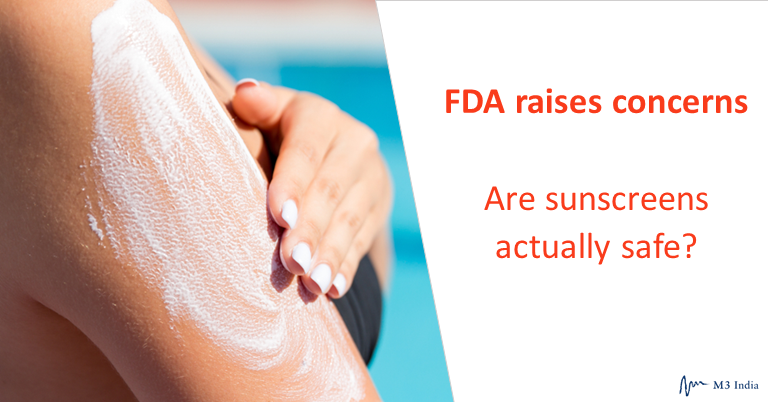FDA raises concerns: Are sunscreens actually safe?
M3 Global Newsdesk Jul 27, 2019
A day at the beach just got more complicated. Two significant announcements from the FDA have combined to put a disquieting spotlight on the safety of nearly all sunscreens on the market.

In the first announcement, the agency proposed a rule that would classify 12 of the 16 ingredients commonly found in sunscreens as no longer generally recognized as safe and effective (GRASE), which would mean that—for the first time since sunscreens became an over-the-counter (OTC) products—manufacturers would be required to provide product safety data.
As for the remaining four ingredients, two (para-aminobenzoic acid [PABA] and trolamine salicylate) are known to be harmful and are largely off the market, while the other two (zinc and titanium dioxide) are designated as GRASE.
The FDA proposed additional changes, including:
- Raising the maximum SPF value from SPF 50+ to SPF 60+. This proposed change comes in light of recent research, in which there has been evidence supporting the link between sunscreen products that carry an SPF value of 60 and additional meaningful clinical benefit, according to the agency.
- Requiring more information on package labels, giving greater visibility on the front to the product's active ingredients.
- Requiring that sunscreens with an SPF value of 15 or higher offer broad spectrum protection that covers both forms of exposure to ultraviolet (UV) light, both UVA and UVD.
- Designating products that combine sunscreen with insect repellant as no longer GRASE, and therefore requiring the submission of safety data.
In the second announcement, the FDA described results from its recent randomized study published in JAMA that examined the potential systemic absorption of active sunscreen ingredients. The researchers asked 24 adults to apply sunscreens with one of four key ingredients at the recommended amount (2 mg/1 cm2 applied to 75% body surface area) four times daily for 4 days; 30 blood samples were collected over 7 days from each participant. While this application amount might seem like a lot, it's roughly equivalent to that which a diligent tourist would use over a week-long visit at a tropical resort.
According to the daily blood tests, concentrations in the bloodstream of all four ingredients increased daily through day 4, and had a continued presence after disuse, pointing to an extended half-life. Overall, the investigators found that the active sunscreen ingredients were absorbed into the blood stream at levels that—within days—reached > 0.5 ng/mL, the threshold at which they should trigger FDA requirements for safety studies of systemic carcinogenicity as well as developmental and reproductive effects.
The systemic absorption recorded in the study “does not mean these ingredients are unsafe,” noted authors Kanade Shinkai, MD, PhD, Editor-in-Chief, JAMA Dermatology, and Robert M. Califf, MD, Duke University School of Medicine, Durham, NC, and former Commissioner of Food and Drugs at the FDA, in an accompanying JAMA editorial. “However, the study findings raise many important questions about sunscreen and the process by which the sunscreen industry, clinicians, specialty organizations, and regulatory agencies evaluate the benefits and risks of this topical OTC medication.”
Consumers should continue to use sunscreen while the industry comes up with the data it needs to submit to the FDA, stated David G. Strauss, MD, PhD, director, Division of Applied Regulatory Science, Center for Drug Evaluation and Research (CDER), FDA, in an interview with MDLinx.
“The fact that an ingredient is absorbed through the skin and into the body does not mean the ingredient is unsafe. Rather, this finding calls for further testing to determine the safety of that ingredient for repeated use,” wrote Janet Woodcock, MD, director, CDER, FDA, and Theresa M. Michele, MD, director, CDER’s Division of Drug Products, Office of New Drugs, FDA, in a recent statement.
It has long been established that sunscreen is effective at reducing the risk of developing squamous cell carcinoma, a common form of skin cancer. Furthermore, according to some research, regular sunscreen use may also reduce the risk of developing melanoma, the deadliest form of skin cancer, although to a lesser degree.
Therefore, ditching sunscreens altogether out of unproven safety concerns “could have significant negative health implications,” wrote Drs. Califf and Shinkai.
More than 3 million Americans develop skin cancer annually, making it the most common form of malignancy in the United States. UV rays—particularly UVB rays— are the biggest culprit. The issue is of heightened concern in the Southwest—including southern California, Arizona, New Mexico, and western Texas—where residents have the highest exposure to UVB rays.
Sunscreen manufacturers have long balked at the idea of performing safety studies themselves, forcing the FDA to conduct its own studies, according to background information recounted in the JAMA editorial. Given the recent data on the systemic absorption of active sunscreen ingredients, however, Drs. Califf and Shinkai expressed that the time has come for manufacturers to demonstrate through research that the benefits of their products—be they sprays, creams, lotions, gels, or even shampoos—outweigh the risks.
One question that Drs. Califf and Shinkai call “urgent” concerns the level of absorption in infants and children, who were not included in the study. Of note, babies have a greater skin surface area relative to their body weight.
That may leave some consumers, especially parents, with a quandary: To slather, or not to slather?
For those with heightened concerns surrounding sunscreen use, health experts recommend reverting to the traditional safety precautions used before sunscreens became ubiquitous: long sleeves, pants, hats, and sunglasses. And then there is this truly old-school one as well: Stay in the shade.
This story is contributed by Kathleen O'Brien and is a part of our Global Content Initiative, where we feature selected stories from our Global network which we believe would be most useful and informative to our doctor members.
-
Exclusive Write-ups & Webinars by KOLs
-
Daily Quiz by specialty
-
Paid Market Research Surveys
-
Case discussions, News & Journals' summaries